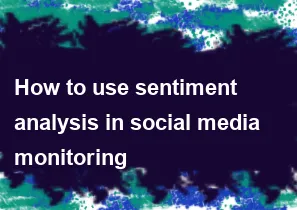How to use sentiment analysis in social media monitoring

Sentiment analysis in social media monitoring involves analyzing and understanding the emotions, opinions, and attitudes expressed in social media content. This can be valuable for businesses, organizations, and individuals to gauge public perception, track brand sentiment, and identify trends. Here's a step-by-step guide on how to use sentiment analysis in social media monitoring:
Define Your Objectives:
- Clearly define the goals and objectives of your social media monitoring. Understand what specific sentiments or emotions you want to track and analyze (e.g., positive, negative, neutral).
Select Social Media Platforms:
- Identify the social media platforms where you want to monitor sentiment. Popular platforms include Twitter, Facebook, Instagram, LinkedIn, and others depending on your target audience.
Choose a Sentiment Analysis Tool:
- There are several sentiment analysis tools and platforms available that can automate the process of analyzing social media content. Examples include:
- Natural Language Processing (NLP) Libraries: NLTK, SpaCy, and TextBlob are Python libraries with sentiment analysis capabilities.
- Commercial Tools: Services like Brandwatch, Hootsuite, and Sprout Social often include sentiment analysis features.
- There are several sentiment analysis tools and platforms available that can automate the process of analyzing social media content. Examples include:
Access Social Media APIs:
- To collect data from social media platforms, you may need to use their APIs. Twitter, for example, provides the Twitter API that allows developers to access tweet data.
Preprocess Data:
- Clean and preprocess the social media data before sentiment analysis. This may involve removing irrelevant content, handling emojis, dealing with hashtags, and tokenizing the text.
Apply Sentiment Analysis Model:
- Use the chosen sentiment analysis tool or model to analyze the preprocessed social media content. The analysis will typically classify each piece of content into positive, negative, or neutral categories.
Train Custom Models (Optional):
- Depending on your specific needs, you may consider training custom sentiment analysis models using machine learning. This requires labeled data for training and can provide more accurate results for industry-specific or unique contexts.
Monitor Real-time Sentiment:
- Implement a real-time monitoring system to keep track of sentiment as it evolves over time. This can be particularly important during events or product launches.
Identify Trends and Insights:
- Analyze the aggregated sentiment data to identify trends, patterns, and key insights. Understand how sentiment correlates with events, marketing campaigns, or product releases.
Take Action:
- Based on the insights gained from sentiment analysis, take appropriate actions. This might include responding to negative feedback, amplifying positive sentiment, or adjusting marketing strategies.
Iterate and Improve:
- Continuously monitor and refine your sentiment analysis process. Incorporate feedback, update models, and adapt to changes in social media dynamics.
Remember that sentiment analysis may not always be perfect, and human review may be necessary, especially in cases of sarcasm or nuanced language. Regularly assess the accuracy of your sentiment analysis and refine your approach as needed.
-
Popular Post
- How to optimize for Google's About This Result feature for local businesses
- How to implement multi-language support in an Express.js application
- How to handle and optimize for changes in mobile search behavior
- How to handle CORS in a Node.js application
- How to use Vue.js with a UI framework (e.g., Vuetify, Element UI)
- How to configure Laravel Telescope for monitoring and profiling API requests
- How to create a command-line tool using the Commander.js library in Node.js
- How to implement code splitting in a React.js application
- How to use the AWS SDK for Node.js to interact with various AWS services
- How to use the Node.js Stream API for efficient data processing
- How to implement a cookie parser middleware in Node.js
- How to implement WebSockets for real-time communication in React
-
Latest Post
- How to implement a dynamic form with dynamic field styling based on user input in Next.js
- How to create a custom hook for handling user interactions with the browser's device motion in Next.js
- How to create a custom hook for handling user interactions with the browser's battery status in Next.js
- How to implement a dynamic form with dynamic field visibility based on user input in Next.js
- How to implement a dynamic form with real-time collaboration features in Next.js
- How to create a custom hook for handling user interactions with the browser's media devices in Next.js
- How to use the useSWRInfinite hook for paginating data with a custom loading indicator in Next.js
- How to create a custom hook for handling user interactions with the browser's network status in Next.js
- How to create a custom hook for handling user interactions with the browser's location in Next.js
- How to implement a dynamic form with multi-language support in Next.js
- How to create a custom hook for handling user interactions with the browser's ambient light sensor in Next.js
- How to use the useHover hook for creating interactive image zoom effects in Next.js